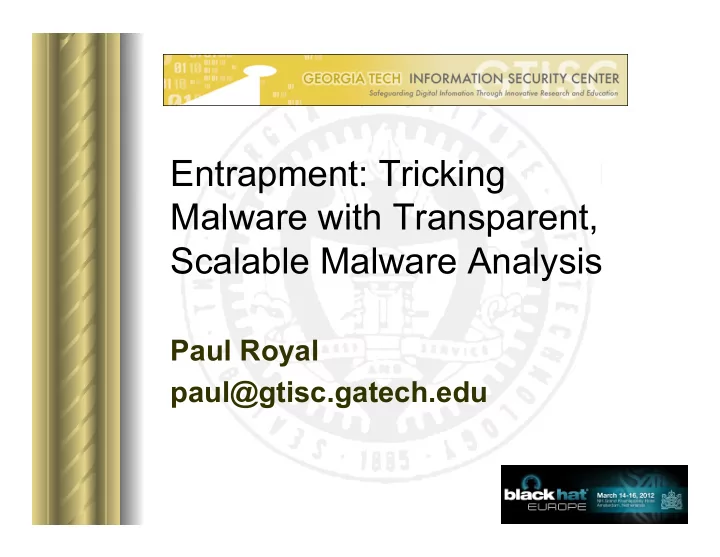

Entrapment: Tricking Malware with Transparent, Scalable Malware Analysis Paul Royal paul@gtisc.gatech.edu
Agenda Modern Malware – Obfuscations, Server-side Polymorphism, Collection Volume Malware Analysis Detection – Commoditization, Popularity, Transparency – Detecting QEMU, VMware, KVM Baremetal Malware Analysis – Hardware, Technologies – Non-Virtual Machine Trace (NVMTrace), a PoC Baremetal Malware Analysis Tool Conclusion/Future Work
Modern Malware
Modern Malware The centerpiece of current threats on the Internet – Botnets (spamming, DDOS, etc.) – Information Theft – Financial Fraud Used by Real Criminals – Criminal Infrastructure – Domain of Organized Crime
Malware Cont’d There is a pronounced need to understand malware behavior – Threat Discovery and Analysis – Compromise Detection – Forensics and Asset Remediation Malware authors make analysis challenging – Direct financial motivation
Malware Obfuscations Pictorial Overview Transformed Machine Code Machine Code (Appears as Data) <Unpack Code> Push EBP � Encrypt/ MOV EBP, ESP � Compress/ SUB ESP, 8 Transform � CALL 00401170 � … … Obfuscation Tool Program A Program A’ Project ZeroPack ZeroPack
Obfuscations Cont’d Server-side Polymorphism – Automate mutations When done professionally: Waledac Collected on 12/30/2008 Collected on 2/25/2009
Why Automation? Vastly increased volume of samples GTISC averages 1M new samples/ month – Higher for commercial security organizations Volume makes manual analysis untenable
Malware Analysis Detection
Malware Analysis Detection Environment-aware Malware – Conficker • Checks for relocated LDT – TDL4 • Checks for device emulation via WQL – Bredolab • Checks for for device emulation via DeviceIoControl()
Detection Cont’d Analysis tool/environment detection is a standard, inexpensive option
Transparency Requirements Higher Privilege No Non-privileged Side Effects Same Instruction Execution Semantics Identical Exception Handling Identical Notion of Time
Requirements Cont’d In-Guest Tools – No higher privilege – Non-privileged side effects – Exception handling issues Reduced Privilege Guests (VMware, etc) – Non-privileged side effects Emulation (QEMU, Simics) – No identical instruction execution semantics
Detecting QEMU IRETD with 0x26 prefix #include <stdlib.h> #include <stdio.h> int main(int argc, char *argv[]) { #include <windows.h> unsigned int handler = int seh_handler(struct _EXCEPTION_RECORD (unsigned int) seh_handler; *exception_record, void *established_frame, printf("Attempting QEMU detection.\n"); struct _CONTEXT *context_record, void *dispatcher_context) __asm("movl %0, %%eax\n\t" { "pushl %%eax\n\t":: printf("Malicious code here.\n"); "r" (handler): "%eax"); exit(0); } __asm("pushl %fs:0\n\t" "movl %esp, %fs:0\n\t"); __asm(".byte 0x26, 0xcf"); __asm("movl %esp, %eax"); __asm("movl %eax, %fs:0"); __asm("addl $8, %esp"); return EXIT_SUCCESS; }
Detecting VMware, KVM VMware – Older versions primarily use binary software translation • SYSRET treated as NOP when executed in ring 3 KVM – Uses hardware virtualization extensions • Certain instructions cause VMExits • Older versions terminate with unhandled exit on guest execution of VMREAD
Why Transparency? Analysis environment detection commoditized, popular Detection vulnerability trend does not suggest decrease over time Certain types of detection vulnerabilities automatically discoverable
Baremetal Malware Analysis
Baremetal Challenges Conceptual – Physicalizing virtual machine Scalability – Cost of hardware – Efficiency of processing Automation – Managing system state – Ensuring longevity of hardware
Baremetal Cluster Hardware Baremetal Controller – Supermicro 5016I-MTF • X3430 Processor, 8GB RAM, 4 x 250GB disks Baremetal Non-Virtual Machine (NVM) – Supermicro 5015A-PHF • Integrated Atom processor, 1GB RAM Cluster Networking – Cisco WS-C2960-24TC-S • 24 10/100Mb, 2 1Gb Ethernet ports
Baremetal Cluster Technologies Linux Device Mapper – Create Copy-on-Write (CoW) block device ATA-over-Ethernet (AoE) – Make CoW device available over network g Preboot eXecution Environment (gPXE) – Boot NVM into OS on network CoW device Intelligent Platform Management Interface (IPMI) – Manage NVM system state
NVMTrace Software controller for automated baremetal malware analysis – Executes each sample in its own sterile, isolated non-virtual machine Provides access to NVM disk contents and network traffic – Use with your favorite network traffic and disk forensic tools
NVMTrace Corner Cases System Clock – Sample can modify system time – Modify gPXE to set sane value, sync immediately prior to sample execution NVM PSU Lifetime – Turning NVM on, off hundreds of times each day quickly destroys PSU – Use resets instead
Conclusion Analysis environment detection commoditized, increasingly popular – Virtualization still a valuable analysis tool, but can be supplemented Advances in hardware make scalable baremetal malware analysis possible NVMTrace facilitates automated baremetal malware analysis
Future Work AoE Disk Forensics – Examine controller-NVM AoE network traffic – Record disk-level events as they occur Arduino Boards – Connect to NVM via USB – Inject keyboard/mouse events – Activate trigger-based malware
Acknowledgements Robert Edmonds – System design Michael Lee – System implementation Artem Dinaburg – Environment detection David Dagon – System concept
Please fill out your feedback forms.
Questions? NVMTrace Source http://code.google.com/p/nvmtrace
Recommend
More recommend